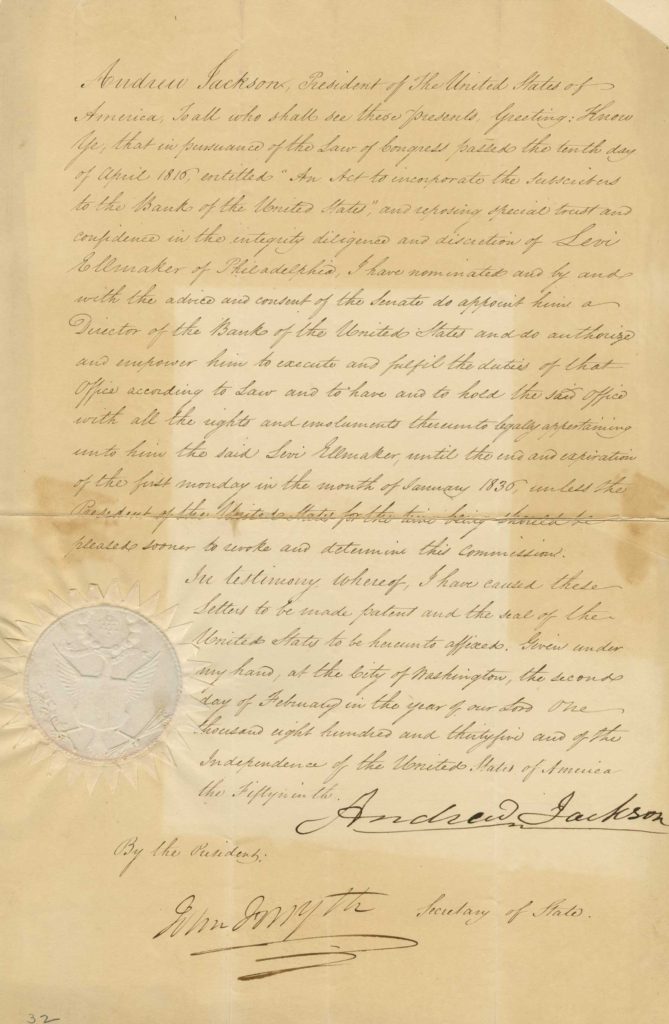President Andrew Jackson, Arch Enemy of the Second Bank of the United States, Appoints For a Bank Directorship a Man Who Would Help Wind Up Its Affairs

The Bank Directors object, which leads to a battle between them and Jackson over this very man's appointment
One of only a handful of Directors appointments of the Second Bank to reach the market
The Second Bank of the United States was chartered in 1816 for a term of 20 years. The time limitation reflected the concerns of many in Congress about the concentration of financial power in a private...
One of only a handful of Directors appointments of the Second Bank to reach the market
The Second Bank of the United States was chartered in 1816 for a term of 20 years. The time limitation reflected the concerns of many in Congress about the concentration of financial power in a private corporation. The Bank became a depository for Federal funds and paid national debts, but it was answerable only to its directors and stockholders and not to the electorate. Jackson had been financially damaged by speculation and a tightening of bank credit early in his business career, and he retained a distrust of financial institutions throughout his life. In January 1832, the Bank’s supporters in Congress, principally Daniel Webster and Henry Clay, introduced Bank recharter legislation. They felt that Jackson would not risk losing votes in Pennsylvania and other commercial states by vetoing it, but they were wrong. Jackson’s opposition to the Bank became almost an obsession, and his anger over it, and the greed he felt was behind it, grew in the spring of 1832 as the June showdown debate on recharter passage loomed in Congress.
Jackson vetoed the Bank Recharter Bill on July 10, 1832, arguing that in the form presented to him it was incompatible with “justice,” “sound policy” and the Constitution. He said in his veto message that it gave the bank considerable, almost monopolistic, market power, specifically in the markets that moved financial resources around the country and into and out of other nations. That market power increased the bank’s profits and thus its stock price, “which operated as a gratuity of many millions [of dollars] to the stockholders,” who, Jackson stated, were mostly “foreigners” and “our own opulent citizens.” The people were with Jackson, and he was overwhelmingly elected to a second term the following November. After his reelection, Jackson announced that the Government would no longer deposit Federal funds with the Bank and would place them in state banks. Supporters of the Bank in the Senate were furious and took the unprecedented step of censuring Jackson. The President held fast, however, and when the Bank’s charter expired in 1836, it was never renewed.
In Jackson’s veto message, he noted the composition of the Directors of the Bank. “In another of its bearings this provision is fraught with danger. Of the twenty-five directors of this bank five are chosen by the Government and twenty by the citizen stockholders. From all voice in these elections the foreign stockholders are excluded by the charter. In proportion, therefore, as the stock is transferred to foreign holders the extent of suffrage in the choice of directors is curtailed. Already is almost a third of the stock in foreign hands and not represented in elections. It is constantly passing out of the country, and this act will accelerate its departure.”
In July of 1834, Andrew Jackson nominated and received Senatorial consent to appoint Levi Ellmaker of Philadelphia, a relative outsider, to one of the five Directorships of the bank over which he had authority. Ellmaker was not a stockholder in the bank, likely reflecting Jackson’s disdain for the inner workings of the institution. Ellmaker was denied a seat by the Board of the bank, even though he carried a commission signed by President Jackson and had been approved by the Senate. Ellmaker protested, saying that the Board had no authority to override a Presidentially appointed Board member who had received the consent of the Senate. The Board disagreed, noting that the Act of Congress of 1816 creating the bank had made it a requirement that all Board members appointed by the President be stockholders.
This action must have infuriated Jackson, who insisted on renominating Ellmaker again, which he did with this very document.
Document signed, Washington, February 2, 1835, executed by Jackson as President and John Forsyth as Secretary of State. “…Know ye that in pursuance of the Law of Congress passed the tenth day of April 1816, entitled, ‘An Act to incorporate the subscribers to the Bank of the United States,’ and reposing special trust and confidence in the integrity and diligence and discretion of Levi Ellmaker of Philadelphia, I have nominated and by and with the advice and consent of the Senate do approve him a Director of the Bank of the United States…”
Ellmaker’s is a fascinating story, as perhaps another showdown was averted. He died exactly one week after Jackson signed this commission and never took his seat. Whether he would have been able to take his seat is a question history cannot answer.

Frame, Display, Preserve
Each frame is custom constructed, using only proper museum archival materials. This includes:The finest frames, tailored to match the document you have chosen. These can period style, antiqued, gilded, wood, etc. Fabric mats, including silk and satin, as well as museum mat board with hand painted bevels. Attachment of the document to the matting to ensure its protection. This "hinging" is done according to archival standards. Protective "glass," or Tru Vue Optium Acrylic glazing, which is shatter resistant, 99% UV protective, and anti-reflective. You benefit from our decades of experience in designing and creating beautiful, compelling, and protective framed historical documents.
Learn more about our Framing Services








































































































